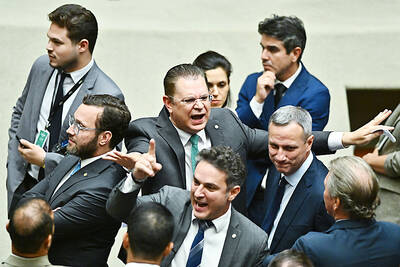An investigation was under way on Saturday into Russia's black market trade in radioactive materials amid concern that quantities of polonium 210, the substance that killed former spy Alexander Litvinenko, are being stolen from nuclear sites.
Officials from Britain's Atomic Weapons Research Establishment and Porton Down, the government's Defense Science and Technology Laboratory were trying on Saturday to track down the precise source of the polonium 210 that was used in the murder of Litvinenko.
As British police drew up a list of witnesses for questioning over the death, experts warned that thefts from poorly protected nuclear facilities in the former Soviet Union were a major problem.
A senior source at the International Atomic Energy Agency (IAEA), said he had no doubt that the killing of Litvinenko was an "organized operation" which bore all the hallmarks of a foreign intelligence agency.
Theories that the death may have involved some form of state sponsorship were being investigated by MI5 and MI6 (British intelligence and counter intelligence) who are investigating the possibility that foreign agents may have been behind the death of Litvinenko.
A senior British security source said they were providing the police with material on "hostile intelligence agencies" operating in the UK, including those from Russia.
"Russia has never really decreased their activity in the UK from the end of the Cold War," he said.
More than anything, the death of the London-based former KGB spy has placed Russia's still thriving trade in radioactive material under scrutiny.
One of the few figures available, a database compiled by researchers at Stanford University in the US, revealed that about 40kg of weapons-usable uranium and plutonium were stolen from poorly protected nuclear facilities in the former Soviet Union between 1991 and 2002.
Although the IAEA has no confirmation of polonium finding its way in to the underground trade, there have been several unconfirmed reports of thefts.
In 1993 the Bulletin of Atomic Scientists reported that 10kg of polonium had disappeared from the Sarov, which produces the rare radioactive material and is described as Russia's own version of Los Alamos, the US government's nuclear research base in New Mexico.
Globally, there have been more than 300 cases during the past four years where individuals have been caught trying to smuggle radioactive material. Last year there were 103 confirmed incidents of trafficking and other unauthorized activities involving radioactive materials, many involving Russia.

PARLIAMENT CHAOS: Police forcibly removed Brazilian Deputy Glauber Braga after he called the legislation part of a ‘coup offensive’ and occupied the speaker’s chair Brazil’s lower house of Congress early yesterday approved a bill that could slash former Brazilian president Jair Bolsonaro’s prison sentence for plotting a coup, after efforts by a lawmaker to disrupt the proceedings sparked chaos in parliament. Bolsonaro has been serving a 27-year term since last month after his conviction for a scheme to stop Brazilian President Luiz Inacio Lula da Silva from taking office after the 2022 election. Lawmakers had been discussing a bill that would significantly reduce sentences for several crimes, including attempting a coup d’etat — opening up the prospect that Bolsonaro, 70, could have his sentence cut to

China yesterday held a low-key memorial ceremony for the 1937 Nanjing Massacre, with Chinese President Xi Jinping (習近平) not attending, despite a diplomatic crisis between Beijing and Tokyo over Taiwan. Beijing has raged at Tokyo since Japanese Prime Minister Sanae Takaichi last month said that a hypothetical Chinese attack on Taiwan could trigger a military response from Japan. China and Japan have long sparred over their painful history. China consistently reminds its people of the 1937 Nanjing Massacre, in which it says Japanese troops killed 300,000 people in what was then its capital. A post-World War II Allied tribunal put the death toll

A passerby could hear the cacophony from miles away in the Argentine capital, the unmistakable sound of 2,397 dogs barking — and breaking the unofficial world record for the largest-ever gathering of golden retrievers. Excitement pulsed through Bosques de Palermo, a sprawling park in Buenos Aires, as golden retriever-owners from all over Argentina transformed the park’s grassy expanse into a sea of bright yellow fur. Dog owners of all ages, their clothes covered in dog hair and stained with slobber, plopped down on picnic blankets with their beloved goldens to take in the surreal sight of so many other, exceptionally similar-looking ones.

‘UNWAVERING ALLIANCE’: The US Department of State said that China’s actions during military drills with Russia were not conducive to regional peace and stability The US on Tuesday criticized China over alleged radar deployments against Japanese military aircraft during a training exercise last week, while Tokyo and Seoul yesterday scrambled jets after Chinese and Russian military aircraft conducted joint patrols near the two countries. The incidents came after Japanese Prime Minister Sanae Takaichi triggered a dispute with Beijing last month with her remarks on how Tokyo might react to a hypothetical Chinese attack on Taiwan. “China’s actions are not conducive to regional peace and stability,” a US Department of State spokesperson said late on Tuesday, referring to the radar incident. “The US-Japan alliance is stronger and more